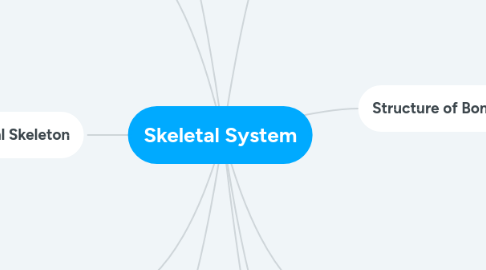
1. Function of the Skeletal System
1.1. Support-Skeleton provides the internal framework of the body. Can only provide this support when the composition of the bone is strong enough to hold the body weight and yet flexible enough to withstand twisting forces.
1.2. Protection-Skeletal system protects soft tissues that are located inside of bony cavities.
1.2.1. Skull protects brain, Ribs protect heart and lungs.
1.3. Movement-Firm attachments between bones and muscles make movement possible.
1.4. Storage-Bones are important in maintaining homeostasis of blood calcium.
1.5. Hematopoiesis-Process of blood cell formation. Process is carried out in red bone marrow.
2. Structure of Bones
2.1. Long Bones- Humerus of Femur
2.1.1. Structures of long bones include; Diaphysis, Medullary Cavity, Epiphyses, Articular Cartilage, Periosteum, Endosteum.
2.2. Short Bones- Carpals
2.3. Flat Bones- Frontal Bone
2.3.1. Structures of flat bones include; layers of cancellous bone between outer layers of compact bone.
2.4. Irregular Bones- Vertebrae
2.5. Sesamoid- Patella
3. Skeletal Variations
3.1. Male-Female Differences
3.1.1. Male skeletons typically have larger bones, different sized pelvic girdles. Women's pelvis is wider to allow for childbirth.
3.2. Age Differences
3.2.1. Human skeleton is considered mature by age 25. After age 50 the skeleton the density of bones start decreasing.
3.3. Environmental Factors
3.3.1. Nutrition, stress, Activity level
4. Joints
4.1. Kinds of Joints
4.1.1. Synarthroses- no movement
4.1.2. Amphiarthroses- slight movement
4.1.3. Diarthroses- free movement
5. Skeletal Disorders
5.1. Tumors- bone tumors (osteosarcoma), Cartilage tumors (chondrasarcoma)
5.2. Bone Diseases- Osteoporosis, Rickets, Osteomalacia, Paget Disease, Osteogenesis imperfecta.
6. Bone Development
6.1. Making and Remodeling
6.1.1. Osteoblasts: bone forming cells Osteoclasts: bone dissolving cells
6.2. Endochondral Ossification
6.2.1. Bones of the body are formed from cartilage models. Many bones of the body are formed this way.
6.3. Intramembranous Ossification
6.3.1. Formation by calcification of fibrous membranes. Skull bones are formed this way.
7. Axial Skeleton
7.1. Skull
7.1.1. Consists of 8 bones that for the cranium. 14 bones form the face, 6 bones in the middle ear.
7.2. Hyoid Bone
7.2.1. Does not form a joint with any other bone of the skeleton. Located in the neck.
7.3. Vertebral Column(Spine)
7.3.1. Consists of 24 separate bones
7.3.2. Cervical region, thoracic region, lumbar region.
7.4. Thorax
7.4.1. 12 pairs of ribs.
8. Appendicular Skeleton
8.1. Upper Extremity
8.1.1. Scapula, Clavicle, humerus, radius, ulna, carpals, metacarpals, phalanges.
8.2. Lower Extremity
8.2.1. Pelvic girdle, coxal bones, femur, patella, tibia, fibula, tarsals, metatarsals, phalanges.

